Steve Madden Bundle
Can Steve Madden Continue Its Fashion Footwear Dominance?
Steve Madden, a fashion industry leader since 1990, is navigating a dynamic landscape. With strategic moves like the acquisition of Kurt Geiger and a global presence including 291 retail stores and a strong e-commerce presence as of December 2024, the company's future hinges on its growth strategy. The fashion industry, valued at $457 billion in 2024, demands constant innovation, making Steve Madden's strategic choices crucial.
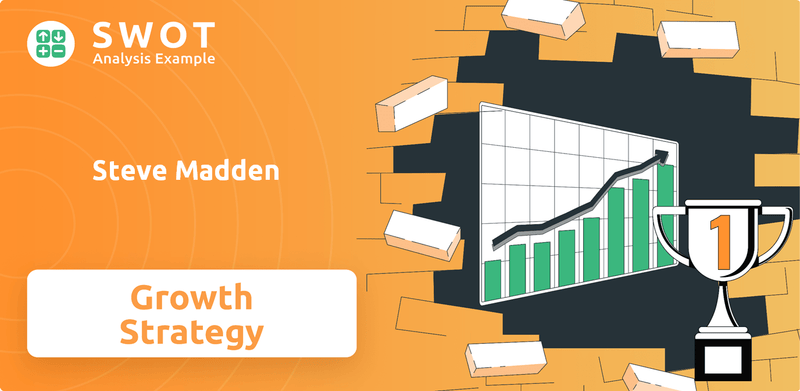
Steve Madden's impressive 2024 performance, marked by a 15% revenue increase and a 9% rise in adjusted diluted EPS, highlights the effectiveness of its Steve Madden SWOT Analysis. This success stems from gains in international markets, non-footwear categories, and direct-to-consumer channels. As we delve into the Steve Madden company analysis, we'll explore how the company plans to leverage its Steve Madden growth strategy to capitalize on Steve Madden future prospects, focusing on brand expansion and international market expansion strategy within the competitive footwear industry trends.
How Is Steve Madden Expanding Its Reach?
The Brief History of Steve Madden reveals a company focused on strategic expansion to fuel its growth. This involves both geographic and product diversification, targeting a broad consumer base with accessible fashion.
The company's expansion initiatives are designed to capitalize on emerging market opportunities and evolving consumer preferences. This includes a significant emphasis on international markets and the expansion of product categories beyond footwear.
These strategies are supported by financial investments, acquisitions, and a focus on direct-to-consumer channels, all aimed at enhancing brand presence and driving revenue growth.
The company is actively expanding into international markets. Revenue growth in international markets was 12% year-over-year in 2024, with EMEA leading at 18% growth. The shift to ownership models, including joint ventures in Latin America, Southeastern Europe, Singapore, Malaysia, and Australia, is a key strategy.
The acquisition of Kurt Geiger in February 2025 for approximately $360.09 million (or £289 million) is a major step. This acquisition is expected to boost international growth, especially in Europe, and enhance the company's 'accessible luxury' offerings. Kurt Geiger's revenue was £400 million for the twelve months ended February 1, 2025.
The company is focused on expanding its non-footwear categories, including accessories and apparel. Revenue from accessories and apparel increased by 53% year-over-year in 2024, or 25% excluding the Almost Famous acquisition. The handbag business surpassed $300 million in revenue in 2024, growing 31% compared to 2023.
The company is also expanding its direct-to-consumer business. Direct-to-consumer revenue reached $550 million in 2024, up 9% year-over-year. As of December 31, 2024, the company operated 291 brick-and-mortar retail stores and five e-commerce websites. The company plans to open 10 new stores in 2024.
The company's growth strategy includes international expansion, acquisitions, and diversification into non-footwear categories. These initiatives are supported by a strong direct-to-consumer presence and strategic retail store openings.
- Transitioning to ownership models in key international markets.
- Acquiring brands like Kurt Geiger and Almost Famous to expand product offerings.
- Growing direct-to-consumer sales and optimizing retail store performance.
- Focusing on outlet stores, which have shown outperformance compared to full-price stores.
Steve Madden SWOT Analysis
- Complete SWOT Breakdown
- Fully Customizable
- Editable in Excel & Word
- Professional Formatting
- Investor-Ready Format
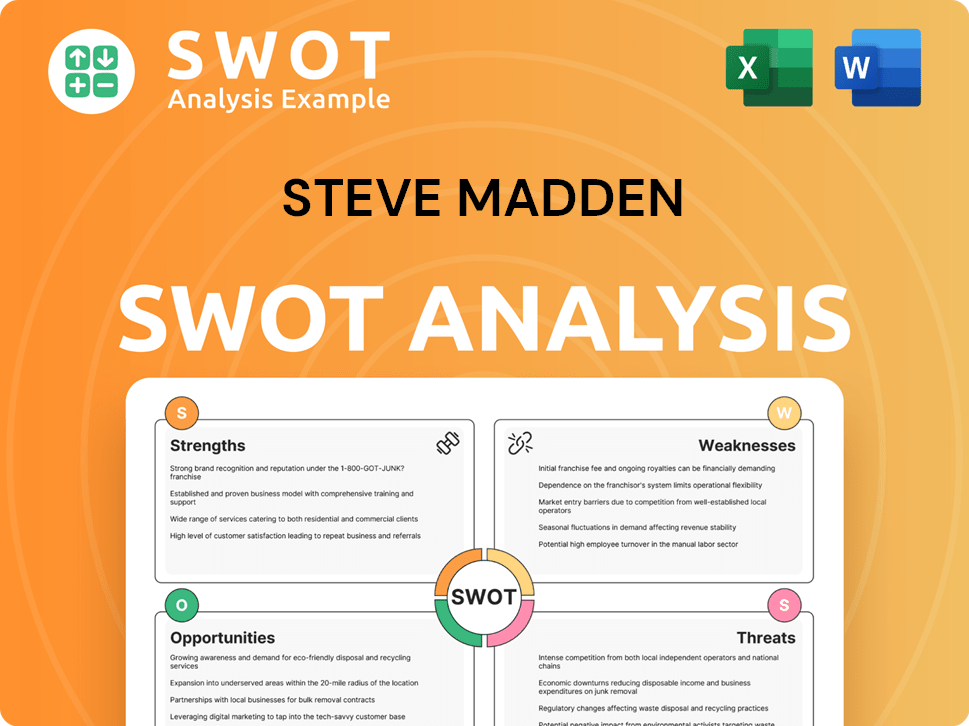
How Does Steve Madden Invest in Innovation?
The company leverages innovation and technology to drive its growth in the fashion industry. This approach includes a focus on product development, digital transformation, and the integration of cutting-edge technologies like AI. The company's commitment to innovation is evident in its investments in design expenses and the development of advanced e-commerce platforms.
A key element of the company's strategy is its rapid response to consumer trends. This 'test-and-react' strategy, combined with its speed-to-market capabilities, allows it to create trend-right products that resonate with consumers. This adaptability is crucial in the fast-paced fashion industry, enabling the company to stay ahead of evolving consumer preferences.
The company's digital transformation efforts, especially in e-commerce, are designed to enhance the consumer experience and streamline operations. The use of AI and data science further supports these goals, driving online sales and improving operational efficiency. These initiatives are integral to the company's long-term growth strategy.
The company invests heavily in its design teams and product development processes. In 2024, the company spent $30.9 million on design expenses. This investment supports the creation of trend-right products.
The company is focused on enhancing its digital capabilities, particularly in e-commerce. The new platform has resulted in a 16% conversion rate increase. This transformation aims to improve the consumer experience and streamline operations.
The company is integrating AI into its operations to enhance the shopping experience. In September 2024, the company partnered with Fast Simon to implement AI shopping optimization solutions. This technology powers search, discovery, personalization, and merchandising.
The company unveiled a revamped global e-commerce platform in March 2025. The platform supports brands like Dolce Vita, Betsey Johnson, and Steve Madden. The platform is designed to enhance digital capabilities and improve consumer experience.
The company invests in digital marketing and data science to boost online sales. These investments are part of a broader digital transformation strategy. The goal is to drive online sales and improve operational efficiency.
The company's 'test-and-react' strategy and speed-to-market capabilities are key. This approach allows the company to quickly adapt to changing consumer trends. This agility is crucial for staying competitive in the fashion industry.
The company’s innovation strategy focuses on product development, digital transformation, and AI integration. These initiatives support its Steve Madden growth strategy and Steve Madden future prospects. The company's investments in technology and design are critical for its Steve Madden company analysis and long-term success.
- Product Design and Development: The company allocates significant resources to design, ensuring its products align with current fashion trends.
- Digital Transformation: The e-commerce platform and AI integration are central to enhancing the consumer experience and streamlining operations.
- Speed-to-Market: The 'test-and-react' strategy allows the company to quickly adapt to changing consumer preferences.
- Financial Commitment: The company's investment in design expenses demonstrates its commitment to innovation.
Steve Madden PESTLE Analysis
- Covers All 6 PESTLE Categories
- No Research Needed – Save Hours of Work
- Built by Experts, Trusted by Consultants
- Instant Download, Ready to Use
- 100% Editable, Fully Customizable
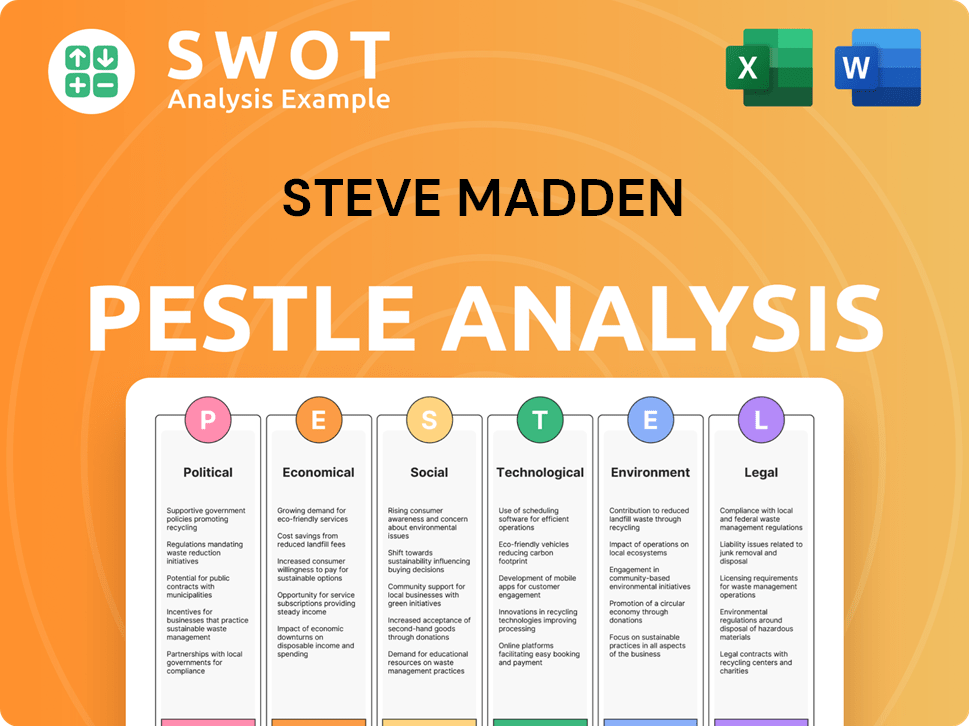
What Is Steve Madden’s Growth Forecast?
The financial performance of the company in 2024 reflects a strong position in the footwear industry. The company's revenue reached $2.28 billion, a significant increase from $1.98 billion in 2023. This growth demonstrates the effectiveness of the company's strategies and its ability to capture market share.
Adjusted diluted earnings per share (EPS) also saw a positive trend, increasing by 9% to $2.67 in 2024 from $2.45 in the previous year. This increase is a key indicator of the company's profitability and operational efficiency. The company’s ability to maintain and grow its earnings is crucial for its future prospects.
Gross profit as a percentage of revenue was 41.0% in 2024, slightly down from 42.0% in 2023. This marginal decrease was primarily influenced by the acquisition of Almost Famous and a greater mix of private label business. Income from operations for 2024 was $224.9 million, or 9.9% of total revenue. Net income attributable to the company was $169.4 million.
The company anticipates a revenue increase of 17% to 19% in 2025. This projection indicates continued confidence in the company's growth strategy. This growth is expected to be driven by brand expansion and market share gains.
The company projects diluted EPS to be in the range of $2.30 to $2.40 for 2025. This forecast is based on the assumption that the Kurt Geiger acquisition closes on May 1, 2025. The actual EPS may vary based on market conditions.
The Kurt Geiger acquisition, completed on May 6, 2025, for approximately £289 million, is expected to be a significant growth driver. Kurt Geiger had revenue of £400 million for the twelve months ended February 1, 2025. This acquisition is a key element of the company's international market expansion strategy.
As of December 31, 2024, the company maintained a strong financial foundation with $203.4 million in cash and cash equivalents, and no debt. Inventory totaled $257.6 million. This strong financial position supports the company's long-term growth potential.
The company's Board of Directors approved a quarterly cash dividend of $0.21 per share, payable on March 21, 2025. Despite uncertainties, the company remains focused on navigating challenges and driving sustainable growth. The company withdrew its previously provided 2025 financial guidance in May 2025 due to uncertainties surrounding new tariffs. To better understand the company's customer base, consider reading about the Target Market of Steve Madden.
Steve Madden Business Model Canvas
- Complete 9-Block Business Model Canvas
- Effortlessly Communicate Your Business Strategy
- Investor-Ready BMC Format
- 100% Editable and Customizable
- Clear and Structured Layout
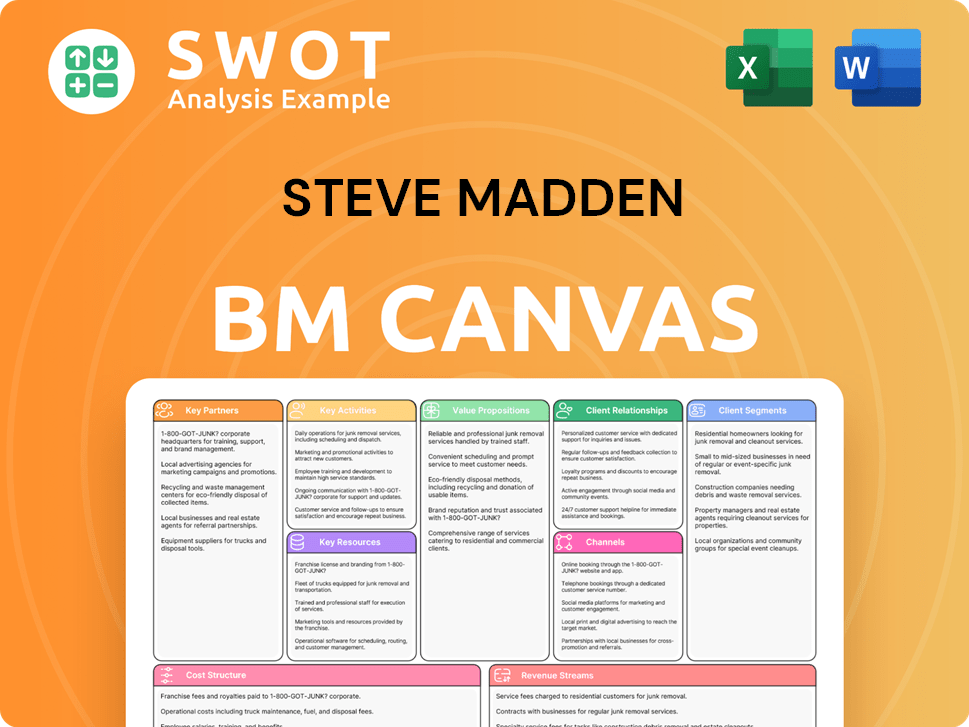
What Risks Could Slow Steve Madden’s Growth?
The path for Steve Madden is fraught with potential risks. The company's growth strategy and future prospects face challenges from various fronts, including intense competition and macroeconomic uncertainties. Understanding these obstacles is crucial for assessing the company's long-term growth potential and financial performance.
One of the primary concerns for Steve Madden is the highly competitive nature of the fashion industry. The low barriers to entry allow both established players and new entrants to compete, potentially impacting Steve Madden's market share. External factors, such as inflation and interest rates, can also significantly affect consumer spending, posing further challenges.
Supply chain vulnerabilities and changes in international trade policies are significant headwinds for Steve Madden's business in 2025. The company's reliance on foreign manufacturing, particularly in China, exposes it to supply chain disruptions and geopolitical tensions. The company is actively working to diversify its supply chain to mitigate these risks, aiming to reduce its China sourcing to mid-single digits by Spring 2026.
The footwear industry is highly competitive, with numerous brands vying for consumer attention. This intense competition can lead to pricing pressures and impact Steve Madden's market share. The company must continually innovate and adapt to stay ahead.
Economic downturns, inflation, and high interest rates can significantly affect consumer spending. These macroeconomic factors can reduce demand for discretionary items like footwear, impacting Steve Madden's financial performance and online sales growth. The company needs to be prepared for these challenges.
Supply chain disruptions and geopolitical tensions pose significant risks. Steve Madden's reliance on foreign manufacturing, particularly in China, makes it vulnerable to these issues. The company is working to diversify its supply chain to mitigate these risks and improve supply chain management.
Technological disruptions and cybersecurity threats are growing concerns. Steve Madden must protect itself from cyber threats and data breaches. The company engages third-parties for annual tabletop exercises to rehearse incident response plans and identify areas for cybersecurity program improvement.
Consolidation and restructuring in the retail industry could reduce distribution channels. This could impact the availability of Steve Madden's products in certain markets. The company needs to adapt its distribution strategy to maintain its retail store performance.
Declining search trends and the impact of marketing investments raise questions about brand equity. Steve Madden must ensure its brand remains relevant and appealing to consumers. The company must carefully manage its brand partnerships and collaborations.
The acquisition of Kurt Geiger, while promising, introduces integration risks. Integrating different business models can be complex. The company must ensure a smooth integration to achieve the expected benefits and maintain its long-term growth potential.
The potential loss of key personnel could impact the company's operations and strategic initiatives. Retaining talented employees is crucial for maintaining innovation and driving growth. Leadership stability is essential for navigating challenges and achieving long-term goals.
Steve Madden Porter's Five Forces Analysis
- Covers All 5 Competitive Forces in Detail
- Structured for Consultants, Students, and Founders
- 100% Editable in Microsoft Word & Excel
- Instant Digital Download – Use Immediately
- Compatible with Mac & PC – Fully Unlocked
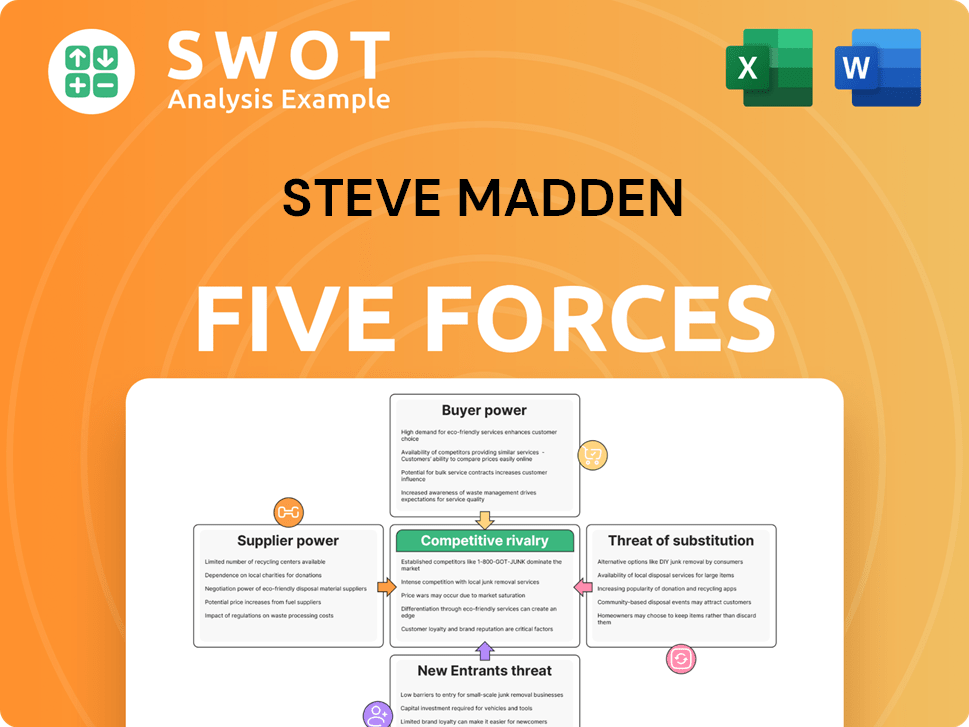
Related Blogs
- What are Mission Vision & Core Values of Steve Madden Company?
- What is Competitive Landscape of Steve Madden Company?
- How Does Steve Madden Company Work?
- What is Sales and Marketing Strategy of Steve Madden Company?
- What is Brief History of Steve Madden Company?
- Who Owns Steve Madden Company?
- What is Customer Demographics and Target Market of Steve Madden Company?
Disclaimer
All information, articles, and product details provided on this website are for general informational and educational purposes only. We do not claim any ownership over, nor do we intend to infringe upon, any trademarks, copyrights, logos, brand names, or other intellectual property mentioned or depicted on this site. Such intellectual property remains the property of its respective owners, and any references here are made solely for identification or informational purposes, without implying any affiliation, endorsement, or partnership.
We make no representations or warranties, express or implied, regarding the accuracy, completeness, or suitability of any content or products presented. Nothing on this website should be construed as legal, tax, investment, financial, medical, or other professional advice. In addition, no part of this site—including articles or product references—constitutes a solicitation, recommendation, endorsement, advertisement, or offer to buy or sell any securities, franchises, or other financial instruments, particularly in jurisdictions where such activity would be unlawful.
All content is of a general nature and may not address the specific circumstances of any individual or entity. It is not a substitute for professional advice or services. Any actions you take based on the information provided here are strictly at your own risk. You accept full responsibility for any decisions or outcomes arising from your use of this website and agree to release us from any liability in connection with your use of, or reliance upon, the content or products found herein.